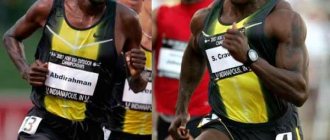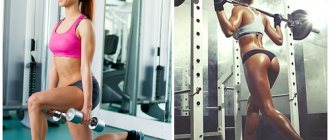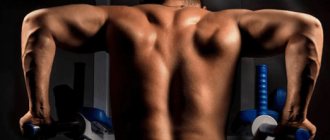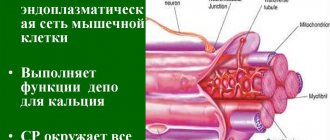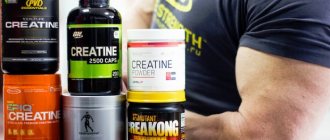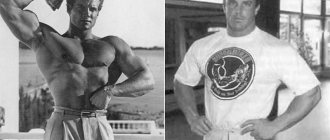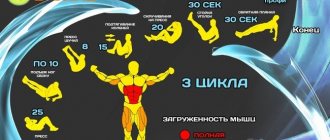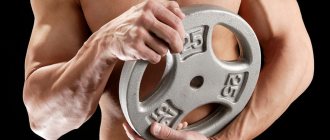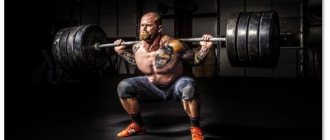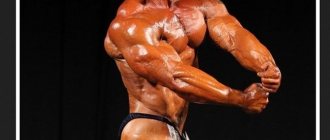The women's strength training program presented in the article will help all girls gain sculpted and elastic buttocks, create a slender and toned figure, by imparting muscle tone to the whole body (we will train both the lower and upper body, based on the characteristics of the female body).
Many girls do not want to come to the gym for fear of building large muscles that will make them look masculine, and as a result, finding a partner for a serious relationship will be much more difficult. This statement about fitness and the gym is simply a myth that has nothing to do with the truth.
There is much less testosterone in the female body than in the male body, which is responsible for the development of male characteristics, including muscle development, aggression, and sexual activity. Therefore, no girl can build up large muscles in the gym, for example, like the female bodybuilders in the photo; for this it is necessary to inject hormonal drugs (steroids).
With regular fitness-style workouts, you can lose excess weight, get in shape, but not increase muscle size , cheer yourself up, keep your body in good shape, as well as strengthen your immune system and speed up your metabolism.
And lastly: a lack of calories, which should be the basis of proper nutrition for weight loss, will never provoke muscle growth. Now let's move on to the training itself.
Content
- 1 Definition of body type 1.1 Endomorphic type
- 1.2 Mesomorphic type
- 1.3 Ectomorphic type
- 2.1 THREE PHASES OF MOTIVATION
- 3.1 SAUT principle
- 6.1 TESTS FOR DETERMINING PHYSICAL INDICATORS
How to engage the LONG HEAD OF THE BICEPS:
- The farther your elbows are behind your back , the more the outer biceps work.
- The more the elbows are brought forward, the more the internal biceps works. (Example: Scott Bench Curl)
- The narrower the grip , the more the external biceps muscle works (not the best option, because with such a grip you will try to bring your elbows forward and engage the internal muscle)
- The wider the grip, the more the internal beam works.
INITIAL STAGE[edit | edit code]
Once you decide to start training, you should know that you will have to go through three phases. This will help you better understand your feelings and moods at each stage. The transition from one phase to another almost never goes smoothly, and that's okay. You may lose faith, you will be ready to give up on everything, but you just have to show persistence and the obstacles will be overcome. If you get bored quickly, make changes to your training program more often. It’s also a good idea to find a training partner at first.
THREE PHASES OF MOTIVATION[edit | edit code]
Resistance phase
During the initial stage, which lasts 6-12 weeks, your motivation will likely be low and your internal resistance will likely be high. The main thing here is perseverance and consistency. Strictly follow the training schedule. The training program should be simple and conservative, but at the same time set quite difficult tasks for you to solve. At this stage, some points are often revealed that have fallen out of sight when a person determines his level of readiness for training. In this regard, you may need to reconsider some of your goals and principles of program organization. Although you are unlikely to feel any physical changes during this time, by the third week you should notice an improvement in your general condition. The first change most people notice is improved sleep.
Transition phase
In the second stage, which lasts 3-6 months, physical changes begin to appear. There is a risk of overtraining because you are eager to improve your results quickly. To avoid this, try to get the most out of the least amount of effort. Use repeated tests of your physical condition, which are carried out three months after the start of training, in order to make adjustments to the program based on the results achieved. At this stage, you begin to notice more subtle aspects of your fitness level and health. The frequency of training usually reaches its maximum at this time.
Intrinsic motivation phase
This moment comes when there is no need to look for external motivation for training and it becomes part of your usual lifestyle. By this time, you have already formed certain priorities, such as aerobics or swimming, and training becomes an integral part of your daily routine. To overcome the so-called plateau period and maintain interest in training, you need to make changes to the program approximately every three months. It's a good idea to use these moments to consult with experts to further tailor your workouts to your individual needs and gain additional technical information.
FEMALE FIGURE from "ZERO". Task No. 2 (reducing diet)
THE MEANING OF ALL DIETS: YOU NEED TO GET LESS CALORIES EVERY DAY THAN YOU SPEND. Everything is very simple. Get a little less food than your body needs, and then it will begin to compensate for this deficiency with fat. The problem with all diets is that they do not take into account the individual “balance point” of a particular person. The amount of food that will lead me to lose weight will only lead you to gain even more fat. This is why the same diets work for some and not for others. And after they end, they always lead to the return of lost weight.
https://youtu.be/hEhUoKZKuY8
PRINCIPLES YOU SHOULD KNOW[edit | edit code]
Functional training involves activities that are somewhat similar to your daily activities. Most functional programs feature compound exercises that work multiple joints and muscle groups simultaneously and use weights or your own body weight. Functional training aims to maintain health and optimal quality of life. As a rule, it includes exercises to develop flexibility, strength, endurance, as well as to strengthen the cardiovascular system, and the last group is considered the most important component, since the general state of health depends on the condition of the heart and blood vessels. Recently, functional training programs have begun to include exercises to strengthen the stabilizing muscles of the trunk, which are responsible for posture.
The principles of exercise are based on the laws of nature. Understanding them will help you train safely and effectively, achieving the best results.
SAUT principle[edit | edit code]
In accordance with the principle of specific adaptation to established requirements (SAUT), your body will predictably change as it adapts to the tasks that are set for you when performing certain exercises. This means that if you regularly perform stretching exercises (stimulus), the body's flexibility will improve (response) as the muscles and ligaments become more elastic (adaptation), allowing for greater freedom of movement. Any component of physical condition can be developed and trained. Adaptation is directly related to response, for example: if you run regularly, your running performance will improve, and if you ride a bike regularly, you will improve your cycling skills. Thus, your training program should be aimed at the desired result.
This principle also explains why it is so important to train in a functional position and in a manner that best suits your lifestyle. For example, if you do exercises while standing, it strengthens the body's stabilizing muscles, which helps you better cope with the demands of everyday life. The speed of adaptation depends on the individual characteristics of each person, but it can be argued that for beginners, especially with a low level of functional training, it happens faster.
The principle of excess load[edit | edit code]
To achieve improvement in physical performance, the body must be exposed to an impact that is slightly greater than its current capabilities. Therefore, if you want to improve your strength, you need to work with a load slightly higher than what you can handle. This effect on the body is called excess load or overload. However, it should be taken into account that too much overload can lead to injury.
CHITP principle[edit | edit code]
There are four components of overload that must be included in every workout. These are frequency, intensity, type and duration. Your training program will be incomplete if at least one of them is missing. To be successful, one of these components must be loaded with the highest possible overload in each workout.
The principle of progression[edit | edit code]
Over time, complete adaptation to the original stimulus occurs and the results stop increasing. To overcome the plateau, you need to increase the load even more.
Reversibility principle[edit | edit code]
The principle has long been known: what you don’t use, you lose. It fully illustrates the principle of reversibility. Adaptations resulting from training stimuli may be lost if the stimulus ends.
The principle of balancing load and rest[edit | edit code]
Rest periods are as integral a part of training as training loads. There must be a balance between them. Too much rest leads to regression, and too much work leads to overtraining.
Essential qualities of a health-promoting exercise program include variety (especially as physical performance improves) and a balance between safety and effectiveness.
Release in audio (mp3) format:
You can find all episodes in audio format HERE
While performing an EXERCISE on the arms (biceps or triceps), the pumper needs to solve TWO TASKS:
- Exclude other muscle groups from work as much as possible so that they do not steal the load (because of this, the trained muscles can often lag behind). For example, a person trains his triceps with presses and push-ups, but only his chest grows. Classic situation.
- Learn to influence the necessary parts of the muscle (bundles) . For example, almost always the outer triceps bundle is developed but the inner one is not. The situation is similar with the biceps.
The solution to both of these issues is within the competence of technology . It is her, our dear one, that we will study most of this lesson. Well, at the end we will talk about the nuances of creating training programs for maximum growth of arm muscles.
A FEW WORDS ABOUT NUTRITION[edit | edit code]
To overcome training loads, you will need a sufficient amount of energy. Therefore, the body must receive as many nutrients of the proper quality as it needs. Whole grains, legumes, fruits, vegetables, seeds and nuts should be eaten raw or minimally processed because they contain balanced amounts of essential nutrients. There should be as many of them in the diet as possible. Try to minimize your consumption of processed foods that contain various additives and preservatives, as well as fried foods and fast food. Consumption of caffeine, alcohol, refined sugar, dairy products and animal proteins should be kept in moderation. In addition, it is necessary to drink clean water regularly.
Minimize the influence of factors that deprive the body of valuable nutrients - smoking, alcohol, stress, medications, etc. They make it difficult to absorb nutrients, increase the body's need for food and worsen digestion. The way you eat is no less important than the quality of the food. You need to chew food slowly and thoroughly, follow a diet, give the body time to absorb nutrients and develop a positive attitude towards food. Don't try to manipulate your diet to justify bad eating habits.
There is no one-size-fits-all workout routine, but you can create a workout routine that best suits your needs and goals, addressing your weaknesses and optimizing your strengths. To objectively assess your physical condition, you need to perform a number of tests. Subjective assessments (“I think I’m too fat” or “I need to lose 10 kilograms”) are often inaccurate because they are based on emotions rather than objective reality.
A professional assessment of your level of readiness for training is a service that you don’t mind paying for. Professionals, such as health center specialists or qualified gym instructors, can help you evaluate your test results more accurately and provide personalized advice.
To get started, use the basic five-step process below. It was created on the basis of standard examination protocols. With its help, you can determine your body type and the four main components of your physical condition, which will help you choose the appropriate set of exercises. Analyzing your results will allow you to create a training program that best suits your goals.
SECRET: To turn on the LONG HEAD YOU NEED:
- Abduction of the arm upward (above the head) . Exercises: French overhead presses.
- During extensions , engage the shoulder joint in the work. Exercise: for example, the French bench press of a barbell from behind the head, and not from the nose. I.e. Our shoulder is under load.
- Pressing the elbows to the body shifts the load to the long head. Raising the elbows to the sides shifts the load to the outer head.
- Supination of the hand - shifts the load to the long head of the triceps, and pronation of the hand shifts the load to the outer head.
While performing isolated exercises on any pushing muscle groups (Triceps, Chest, Deltas, Quadriceps), you CANNOT CHEAT! Those. You can’t do jerks and pushes using other muscles to throw the weight.
Why? Because the work occurs in one joint at a fracture. Jerking in such a situation is 100% an injury sooner or later . By the way, this is why it is important to do isolated exercises after the basic ones (you are more warmed up and your joints are better prepared to work without injury). In general, I will tell you this, 50% of the injuries that I often see are variations of French presses with heavy weights! Those. any triceps exercises that involve work in only one joint (the elbow joint) are very dangerous.
RECOMMENDATION: load your triceps well with basic exercises (close-grip presses and parallel bars, first of all) and only after that you can do isolated exercises , because your triceps will already be tired and you will need lighter, and therefore less traumatic, weights to complete the workout.
STEP #1. ANSWER THE QUESTIONS[edit | edit code]
Before choosing an exercise program, you need to make sure that you are physically ready for training. If you answer yes to any of the questions listed below, be sure to consult with your doctor, who will determine whether exercise is appropriate for you.
- Are you a woman and over fifty-five years old?
- Has there been a history of heart attacks or sudden death in your family among men under the age of fifty-five who are first degree related to you (brother, father) or women under the age of sixty-five (sister, mother)?
- Have you ever been diagnosed with diseases of the cardiovascular and/or respiratory system? Were there any suspicions against them?
- Are you HIV positive?
- Do you have neuromuscular disorders, musculoskeletal disorders, or rheumatoid diseases that may be aggravated by exercise?
- Do you currently smoke (or have you quit in the last six months)?
- Does your blood pressure rise above 140/90 mmHg (at least two cases recorded at different times)? Are you taking medications for hypertension?
- Does your blood cholesterol level exceed 6 mmol/l? Is your high-density lipoprotein level below 1 mmol/L?
- Do you suffer from insulin-dependent diabetes?
- Are you currently leading a sedentary lifestyle?
- Have you ever experienced loss of consciousness, unexplained fatigue, pain, shortness of breath, rapid heartbeat, or dizziness?
- Have doctors advised you to avoid physical activity?
- Do you suffer from illnesses or injuries that may be aggravated by exercise?
- Are you currently pregnant? Did you give birth to a child less than three months ago?
- Have you had surgery in the last three months?
- Is there any other reason that makes exercise undesirable for you?
WOMEN'S BAR SQUATS for buttocks (task No. 3)
There are many such exercises. But the most important ones are the two SQUATS WITH A BAR ON THE SHOULDER and the STRAIGHT LEG DEAD LIFT. These two exercises for girls are like the bench press and pull-ups for men. And we will start today with the correct SQUAT technique. In my opinion, this is the most important exercise for any woman. Some women are afraid to do it because they already have too big a butt and squats will disfigure it even more. This is a very big mistake because they confuse fat with muscle. In 100% of cases, when you see a woman with a big and ugly butt, it means that there is a lot of fat there, and not muscle at all. The key to a beautiful and firm butt is a well-developed gluteal muscle with a minimum percentage of fat. It looks very sexy and appetizing.
STEP #2. CONDUCT TESTS AT HOME[edit | edit code]
These tests will help you choose the most suitable training program. All tests must be completed in the specified sequence within one day. Two hours before they take place, refrain from eating large meals. Dress comfortably so that your clothes do not restrict your movement. To achieve accurate results, all tests must be performed strictly according to the instructions. Test again after three months and then every six months to assess your progress and make adjustments to your training program if necessary. If at any time you feel weak or dizzy, stop taking the tests and consult your doctor before trying again.
TESTS FOR DETERMINING PHYSICAL INDICATORS[edit | edit code]
Height measurement, cm
Height is measured standing, without shoes. The measuring bar is applied to the crown parallel to the floor. Result
:… cm.
Weighing, kg
Weighing is done standing, without shoes. It is advisable to use lever scales. Result
…. kg.
Determination of body mass index (BMI), kg/m2
BMI is a ratio of body weight to height. Determined by dividing mass (kg) by height squared (m2). Result
:… kg/m2.
Measurement of heart rate at rest, beats per minute
Sit back and relax. Count the number of times your pulse beats in your wrist or carotid artery in your neck for one full minute. Start counting from zero. Result
:... beats per minute.
Flexibility test
This test usually evaluates the flexibility of the body. For this, a special device is used to determine what point a person can reach while sitting with straightened legs. You can make such a device yourself from an ordinary measuring tape. Sit on the floor with your legs completely straight. Shoes should be removed with toes pointing straight up. Place a measuring tape on the floor between your legs so that your heels are at the 26 centimeter mark. With one hand on top of the other, lean your whole body forward as far as you can and extend your arms. While bending, exhale and hold for three seconds at the very end point. Mark the distance in centimeters. Try again 3 times and record the maximum result. Result:... see
Strength endurance test
The goal of the test is to do as many push-ups as possible while on your knees. The exercise should be performed rhythmically and without rest. In the upper position, the arms are fully straightened, and in the lower position, the chest is at a distance of 5 centimeters from the floor. There are no time limits. The test is stopped if you can no longer maintain the specified pace and correct technique or if you feel pain. This test provides insight into the strength of the stabilizing muscles of the trunk. If you are unable to keep your shoulders, pelvis and knees in a straight line, this indicates weakness in your back and abdominal muscles. As an alternative, you can raise your pelvis from the same starting position, but this will create a somewhat inflated impression of your endurance. Result
:…repetitions.
Three-minute step test
This is one of the most universal tests for checking physical condition. It is used to measure the rate of recovery of the cardiovascular system. It is based on a linear relationship between aerobic exercise and the recovery process. The faster the activity of the cardiovascular system returns to normal, the better your physical condition. To perform the test, you need a step platform or other stand that is 30 centimeters high and wide enough to fit two feet on it. You will also need a stopwatch and a metronome set to 96 beats per minute, which means 24 full cycles of getting on and off the platform. After 3 minutes, immediately sit on the step platform and measure your heart rate for one full minute. You need to start measuring your pulse no later than 5 seconds after finishing the exercise. Result
:... beats per minute.
Lifting dumbbells for biceps while sitting on an inclined bench
Lifting dumbbells while sitting on a bench works great for the peak of the biceps; both biceps are involved in the work equally and evenly. The triceps are not involved in this exercise at all, which allows you to create maximum load on the target muscle.
The angle of the bench on which you are sitting should be slightly less than 90 degrees; to do this, first align the back of the bench perpendicular to the floor, and then move it a couple of positions back.
Do dumbbell lifts alternately, with your shoulder blades firmly pressed against the back of the bench and your elbows pressed to your body. There is no need to throw dumbbells to your head and do other stupid things, just lift the load with your clean biceps and contract it at the top point of the amplitude.
At this point, arm training smoothly moves from pumping biceps to triceps. This approach will allow you to pump blood into the muscles as much as possible, causing an incredible feeling of pumping, which will supply the muscles with oxygen and nutrients, creating conditions for their growth.
STEP #3. CALCULATE YOUR RESULTS[edit | edit code]
Using Tables 1, 2 and 3 below, determine your fitness rating by age group. Record your results in Table 4. The purpose of this procedure is to select a training program for yourself based on the tests. Using the recommendations given in Table 4, you can choose the package that best suits your needs.
Please note that the test results are rather conditional. In addition, the determination of body mass index can have an error of up to 5 percent.
Table 1. Interpretation of body mass index and approximate determination of fat content in body tissues, %
| Category | BMI | Disease risk | 20-39 years old | 40-59 years old | 60-79 years old |
| Underweight | <18,5 | Elevated | <21% | < 23% | < 24% |
| Normal weight | 18,5-24,9 | Average | 21—32% | 23—33% | 24—35% |
| Excess weight | 25-29,9 | Elevated | 33—38% | 34—39% | 36—41% |
| Obesity I degree | 30—34,9 | High | >39% | 140% | >42% |
| Obesity II degree | 35—39,9 | High | >39% | > 40% | >42% |
| Obesity III degree | > 40 | High | > 39% | > 40% | >42% |
Find your BMI in the appropriate column. To the left of it you will see how your physique is assessed, and to the right - the risk of diseases directly related to BMI. Then, in your age group column, find your body fat content. Record the result obtained in table 4. Please note that calculating the percentage of fat content according to this table is not particularly accurate and suffers from errors if a person is very thin or, conversely, too fat. If possible, determine this indicator at a local gym or health center, where they use a method of measuring skin folds in various parts of the body using a special caliper and BMI is calculated using more accurate formulas.
| Table 2 Determination of fitness rating based on BMI, flexibility test and push-ups (20-49 years) | ||||||||||
| 20-29 years old | 30-39 years old | 40-49 years old | ||||||||
| Level | Rating % | BMI | Flexibility test | Push ups | BMI | Flexibility test | Push ups | BMI | Flexibility test | Push ups |
| Much above average | 90+ | <14,9 | > 43 | > 32 | <15,5 | > 42 | >31 | < 18,5 | >40 | >28 |
| Above average | 70-89 | 19—15 | 38-42 | 22—31 | 20—15,6 | 37-41 | 21—30 | 23,5—18,6 | 35—39 | 18—27 |
| Average | 50-69 | 22,1—19,1 | 34—37 | 16—21 | 23,1—20,1 | 33—36 | 14—20 | 26,4—23,6 | 31—34 | 12—17 |
| Below the average | 30-49 | 25,4—22,2 | 29—33 | 11—15 | 27—23,2 | 28—32 | 10—13 | 30,1—26,5 | 26—30 | 7—11 |
| Much below average | 10-29 | 32,1—25,5 | 22—28 | 5—10 | 32,8—27,1 | 21—27 | 4—9 | 35—30,2 | 19—25 | 2—5 |
| Table 2 (50-69 years old) | |||||||
| 50-59 years old | 60-69 years old | ||||||
| Level | Rating, % | BMI | Flexibility test | Push ups | BMI | Flexibility test | Push ups |
| Much above average | 90+ | <21,6 | > 40 | > 28 | <21,1 | > 37 | > 25 |
| Above average | 70—89 | 26,6—21,7 | 35—39 | 13—22 | 27,5—21,2 | 31—36 | 12—24 |
| Average | 50—69 | 30,1—26,7 | 30—34 | 9—12 | 30,9—27,6 | 28—30 | 6—11 |
| Below the average | 30—49 | 33,5—30,2 | 26—29 | 3—8 | 34,3—31 | 24—27 | 2-5 |
| Much below average | 10—29 | 37,9—33,6 | 19—25 | — | 39,3—34,5 | 18—23 | — |
In the column corresponding to your age group, find your test results and determine on the left side your fitness level and rating for each of them. Enter the obtained data into Table 4.
| Table 3 Determination of physical fitness rating based on measurement of heart rate at rest and step test (18-45 years) | |||||||
| 18-25 years old | 26-35 years old | 36-45 years | |||||
| Level | Rating, % | Pulse at rest | Step test | Pulse at rest | Step test | Pulse at rest | Step test |
| Much above average | 90 + | <60 | <83 | <59 | <86 | <59 | <87 |
| Above average | 70—89 | 66—59 | 100—84 | 66—60 | 103—87 | 66-60 | 104—88 |
| Average | 50—69 | 72—66 | 112—101 | 70—67 | 116—104 | 71—67 | 114—105 |
| Below the average | 30—49 | 78—73 | 124—113 | 76—71 | 127—117 | 78—72 | 127—115 |
| Much below average | 10—29 | 86—79 | 142—125 | 84—77 | j 141—128 | 84—77 | 143—128 |
| Table 3 (46-65 years old) | |||||||
| 46-55 years old | 56-65 years | More than 65 years | |||||
| Level | Rating, % | Pulse at rest | Step test | Pulse at rest | Step test | Pulse at rest | Step test |
| Much above average | 90 + | <60 | <93 | <59 | <92 | £59 | <86 |
| Above average | 70—89 | 66—61 | 106—94 | 67—60 | 106-93 | 66-60 | 104—87 |
| Average | 50—69 | 72—67 | 118—107 | 72—68 | 116—107 | 71—67 | 120-105 |
| Below the average | 30—49 | 77-73 | 126—119 | 77—73 | 127—117 | 76-72 | 127—121 |
| Much below average | 10—29 | 85—78 | 138—127 | 85—78 | 142—128 | 88—77 | 135—128 |
In the column corresponding to your age group, find your test results and determine on the left side your fitness level and rating for each of them. Enter the obtained data into Table 4.
STEP #4. CHOOSE YOUR TRAINING PROGRAM[edit | edit code]
Once you have completed testing, use the tables below to select the appropriate program. In this program, select the section that matches your somatotype. After repeated testing, determine your next program:
- Choosing the right program
If you have shown results that are generally below and much below the average level (two out of three in strength endurance, somatotype and aerobic fitness) and at the same time starting training in the gym for the first time, choose
the initial phase of program No. 1 with a gradual transition to the intermediate phase.
If you have shown results that are generally below average (two out of three in strength endurance, somatotype and aerobic fitness) and at the same time starting training in the gym for the first time, choose
intermediate phase of program No. 1 with a gradual transition to program No. 2 (if you have low indicators in somatotype and aerobic fitness) or to program No. 3 (if you have low indicators in strength endurance).
If you have shown mostly average results with lower scores in somatotype and aerobic fitness and are no longer new to the gym, choose
program #2, retest to determine the next program that will help you lose weight and increase your aerobic fitness level.
If you have shown generally average to above average results with lower scores in somatotype and strength endurance and are no longer new to the gym, choose
program #3, and then retest to determine the next program that will help build strength and improve muscle tone.
Table 4. Entering the results obtained
| Table 4 | |||||||
| Preparation Component | Test | Result | Rating | Level | |||
| Test date | Retest date | Test date | Retest date | Test date | Retest date | ||
| Somatotype | Visual assessment of physique | Remains unchanged | |||||
| Fabric composition | Fat content based on BMI | ||||||
| Flexibility | Flexibility test | ||||||
| Strength endurance | Push-up | ||||||
| Pulse at rest | Pulse measurement for 1 minute. | ||||||
| Aerobic Preparation | Step test and subsequent heart rate measurement | ||||||
Using the information contained in the previous tables, complete Table 4. It contains columns for retesting after three months. At the same time, you can compare your height and weight.
If you are a mostly average to above average performer with lower strength endurance and flexibility scores and are no longer new to the gym, choose
program #4 and then retest to determine the next program that will help strengthen stabilizing and functional muscles and increase flexibility.
If you have performed generally at an average or above average level, are over 55 years of age, and prefer to train primarily at home, select
program #5, and then, if you decide to go to the gym, test again to determine the next program that will help strengthen stabilizing and functional muscles, as well as increase flexibility.
If you showed results where your weakest component was flexibility (below and well below average), select
an additional stretching program that will end your regular workout. Select 6-12 exercises from the final section and perform them 3 times a week, changing them periodically.
